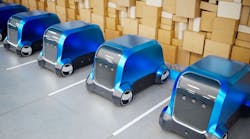One way to break through and speed up large-scale robot deployment, support and maintenance is to think in terms of a new technology introduction in the organization. Practically all companies in the process of digital transformation have tackled this issue. Managing a fleet of robots includes monitoring robots and their execution, managing abnormal situations, making sure robots are ready to do their work with the appropriate sensor payload and manipulating capability, and ensuring all necessary parts are in stock locally or otherwise available in a timely manner to ensure operation and maintenance.
Robot manufacturers and integrated solutions or service providers offer more specific guidance including modular solutions and flexibility. For the end-user, a key to selecting among providers is how they match with business needs from end-to-end, the cost of deploying such technologies, and alignment with digital transformation plans.
Get your subscription to Control's tri-weekly newsletter.
End-users are actively pushing to improve fleet management. Some examples include robot-as-a-service, data-as-a-service, inventory management, remote operation and maintenance and storage of the robot/asset. These have become routine matters, which are supported by manufacturers and integrated solution providers.
Early on, management of the batteries that power robots appeared to be a significant issue. However, battery life, operating practices to maximize battery power efficiency, and charging practices have advanced and are well known.
Key issues continue to be mission management and data compatibility with other systems throughout the enterprise. In this column, we'll dive into mission management.
If they don’t seek guidance from robot manufacturers or integrated solutions providers, end-users could struggle with mission management, which ranges from ensuring robots received their assignments to confirming their tasks are completed. Under some abnormal situations, management must reassign unfinished tasks to a different robot.
Most often, robots perform routine inspections that simulate operator rounds. A simple start is to assign robots to the exact rounds that human operators or technicians would otherwise perform. On the other hand, we've observed many opportunities for improvement. Missions can be streamlined to minimize their duration and battery power use. Rounds can also be designed to make the most of each robot’s capabilities. Their ranges in terms of hearing and sight far exceed those of humans.
Proof-of-concept (PoC) tests have shown that doors and stairs could present problems for robotic rounds. Though some models can handle such obstacles, it's still best to minimize them during missions. The more stairs a robot must climb, the greater the risk that it will encounter a problem.
PoCs have also shown how to minimize the involvement of people, who prepare robots for missions, transport them to mission starting points, perform simple local repairs, and return them to storage following missions.
In other cases, operators found they prefer to see updates to some process variables more often than daily or weekly rounds allow. Process operations are better served by sensors that provide more frequent updates. Robots are typically used for asset management and maintenance purposes.
Finally, managing payloads is another aspect of robot fleet management. Typically, there will be a variety of camera/sensor arrays that depend on the purpose of the missions. Users have found it's best to run all missions using one payload before changing it for a different type of mission. In this case, multiple robots carrying different payloads run in the facility for different purposes.





